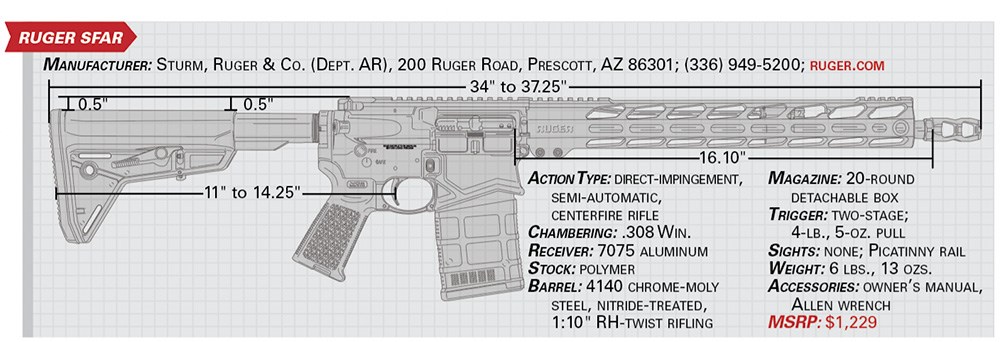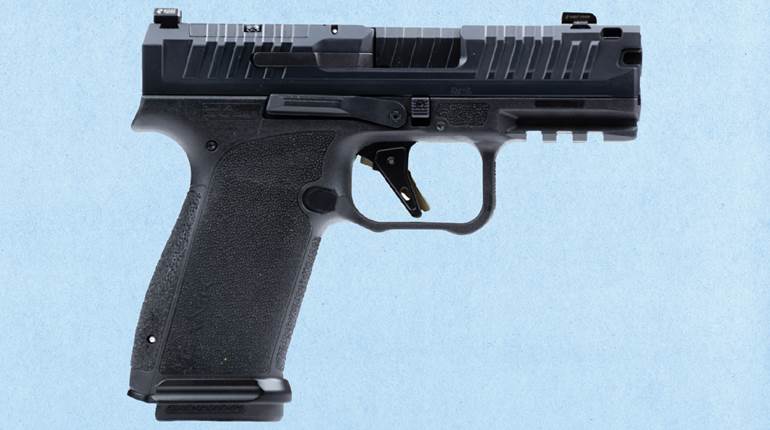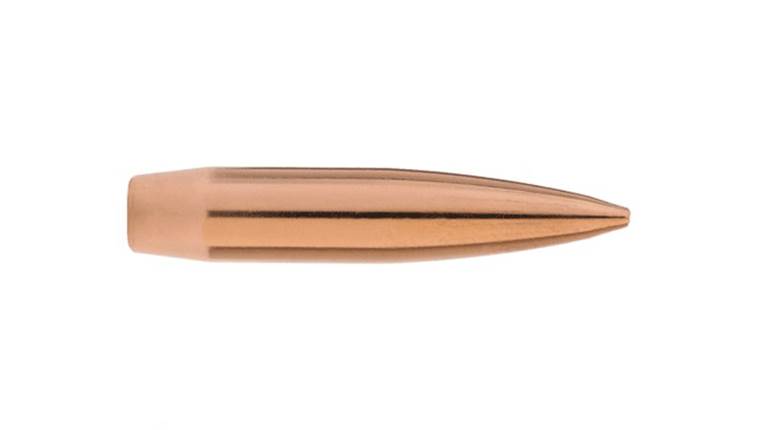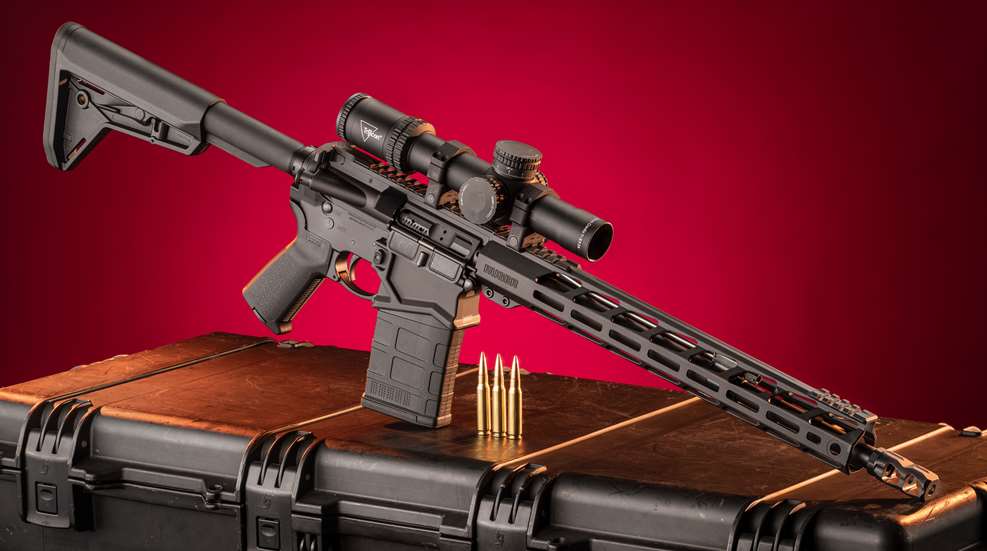
Ruger isn’t just one of the largest and most successful firearm manufacturers in the world. It’s been remarkably adept at getting on the front end of popular trends. One might say those two facts go hand-in-hand; it’s almost a chicken-or-egg kind of situation. Do firearm concepts become popular because Ruger provides quality guns at reasonable prices? Or does the company understand the market so well that it can line up compatible concepts just as sales start to get hot? In a sense, it doesn’t really matter, because the end result is the same. Just look at a few of the company’s fairly recent successes.
Ruger first came to the AR market with an AR-15-size platform, not surprisingly, with its SR-556 entering commercial production in 2009. Responding to its tremendous success, the company stepped up to the .308 platform with its SR-762 in 2014. We highlighted the capability of the SR-762 (July 2014, p. 44) noting that it produced a few impressive groups in our testing and ran reliably. Like nearly all short-action ARs, however, it was bulky and heavy. Unloaded and without an optic, the rifle weighed 8 lbs., 8 ozs., and the increased dimensions of the AR .308 platform made it unwieldy in comparison to its svelte siblings in the AR-15 world. Despite that, the platform soldiered on until 2018, when an oversaturated and depressed AR market made it prudent for Ruger to roll back its commercial lines. But that wasn’t the end of the road for Ruger’s 7.62 NATO AR. The company has come back in a big way with the Small-Frame Autoloading Rifle (SFAR).
The concept of a short, compact, lightweight, AR-15-size, yet .308 Win.-chambered rifle isn’t a novel one, of course, as POF-USA pioneered it in 2017 with its Revolution and subsequent Rogue models in 2020. Despite the enhanced features found on POF’s guns, however, price kept them out of the hands of many. Ruger’s introduction of the SFAR means that a compact, lightweight, AR-style .308 is now easily attainable by many firearm enthusiasts, and that’s a great development for the oft-forgotten .308 AR platform.
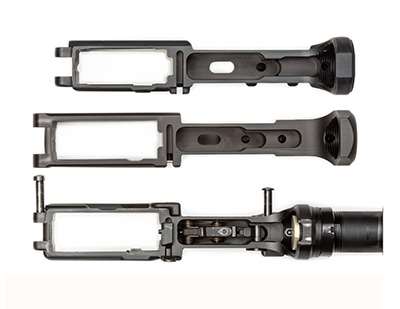
The Measure Of Things
Basically, what Ruger has done in the SFAR is combine the front half, or magazine well, of an AR-10 lower receiver with the back half of an AR-15 lower receiver. A quick look at any DPMS-pattern AR .308 receiver will show substantially more material on the back portion of the receiver as compared to a traditional AR-15 lower. Naturally, it’s an attractive proposition for engineers to trim away unneeded bulk in the pursuit of a compact, lightweight platform like the SFAR.
What this ultimately means is that the Ruger SFAR has a lower receiver that’s functionally the same size as a traditional AR-15 lower, albeit with some necessary dimensional differences. Of course, to accommodate the larger SR-25-pattern magazine, the magazine well needs to be larger than average, and that’s what gives the SFAR’s receiver a somewhat swollen look at the front. A traditional, mil-spec AR-15 receiver measures about 1.1" wide at its front end, with internal dimensions measuring 0.93" wide and 2.38" long. The SFAR measures 1.34" at its front face, with internal dimensions measuring 1.1" wide and 2.95" long.
In terms of overall length, a DPMS-pattern AR .308 receiver measures 8.94" long, as measured from the front of the pivot-pin hole to the end of the receiver. A mil-spec AR-15 receiver measures 7.75" long. Curiously, the SFAR lower receiver measures even shorter than that, coming in at 7.69" long. It’s a fair question to ask what is being given up in these tightened dimensions, and the answer can be found inside the receiver.
For the most part, AR-15s and AR-10s have shared some commonality with respect to fire-control components, with both able to accept a variety of aftermarket triggers. Because of this, the internal portion of the receiver where the trigger, hammer, disconnector, safety selector and springs rest is dimensionally similar across both platforms, and the same is true of the Ruger SFAR, which comes equipped with Ruger’s Elite 452 two-stage AR trigger. The dimensional differences arise in the space between the rear takedown pin and the safety selector, which is substantially shorter on the SFAR than it is on traditional AR-10 lower receivers.
On the SFAR, the rear takedown pin is much closer to the safety selector than it is on more traditional receiver designs. The threaded portion of the receiver that accepts the receiver extension is also nearer to the fire-control components inside the lower.
Externally, length-wise, the SFAR’s upper receiver looks similar to that of a traditional AR-15 receiver, and when placed on a stripped mil-spec AR-15 receiver, the takedown- and pivot-pin holes line up perfectly.
The real changes, however, are underneath—in this case, quite literally, as the cutout on the underside of the SFAR upper necessarily must be bigger to accommodate the SR-25 magazine. This inner portion of the receiver measures 1.07" wide, as compared to a traditional AR-15’s 0.91" width. Also noticeable is the oddly shaped cutout on the bottom face of the upper receiver as compared to that on the AR-15, which accommodates the bolt-catch mechanism at the rear of the magazine well on the lower receiver.
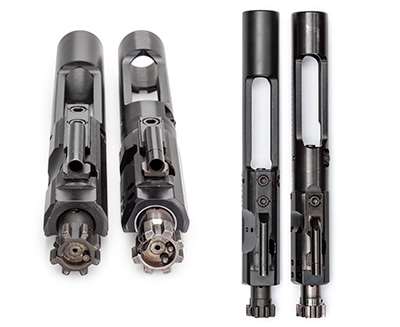
Despite these differences, however, there are several similarities, as well as shared components, between the SFAR upper receiver components and those found on AR-15s. The SFAR is a direct-impingement design, and the bolt carrier is the same length as an AR-15 carrier, with the front half of each bolt-carrier group looking similar. Both are seven-lug designs, and like many AR-15 carriers, the SFAR’s bolt carrier is machined from 8620 steel. There’s also a staked gas key at the top, as well as a DLC-coated titanium firing pin.
At the back half of the carrier, though, is where the real differences begin to emerge. To account for the lengthened span from the rear of the firing pin to the bolt face required to bridge the magazine well, the forward portion of the bolt carrier containing the firing pin, bolt, cam pin and gas key is substantially longer than the same portion of an AR-15 bolt carrier. This means that the opening that allows clearance for the hammer to strike the firing pin is shifted rearward, accounting for much less material on the rear cylinder of the SFAR carrier as compared to that of an AR-15’s.
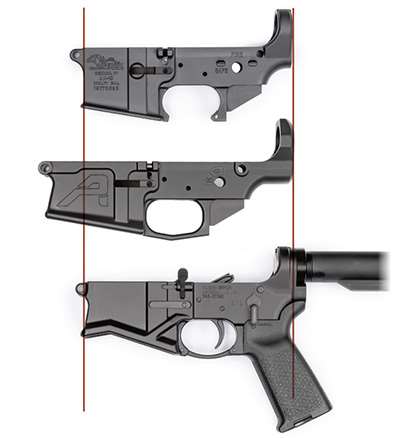
Of course, the bolt itself includes a necessarily enlarged face to accommodate the wider case head of the .308 Win. cartridge. It also includes dual plunger-style ejectors opposite the extractor. The SFAR's bolt body measures 0.500", the same as that on a standard AR-15, but the bolt head itself is where we see some changes, both dimensionally and compositionally. Ruger’s claim of “bigger and stronger where it needs to be” comes into play here, as the company machines its bolts out of an ultra-high-strength alloy steel that exceeds the capabilities of traditional C158 AR bolts.
In addition to being a stronger material, the bolt lugs themselves have been beefed-up. Those on a mil-spec AR bolt measure about 0.1" wide and 0.28" long, while those on the SFAR measure 0.3" long and are actually tapered for additional strength, with a 0.135" base width and a 0.121" width at its top face. Those numbers might not sound like much, but tapered lugs are stronger and there’s a greater amount of material in each SFAR bolt lug, adding even more strength.
On The Outside
Much of the story on the Ruger SFAR design has to do with the changes made to the receiver set, but, of course, there’s the rest of the rifle, which is what most folks care about. Inconsequential nerdery aside, the bottom line is that Ruger’s done a great service to the AR-10 platform by putting this re-designed receiver set within reach of the general public. Two variants of the SFAR are available as of this writing, one with a 16" barrel and another with a 20" barrel.
Our test sample is the 16" model, which, obviously, is the lightest at 6 lbs., 13 ozs., unloaded—significantly lighter than Ruger’s last entry into the .308 Win. AR market. The 4140 chrome-moly steel barrel is cold-hammer-forged and features 5R rifling. It’s a fairly heavy-profile barrel, measuring 0.69" just behind the muzzle and featuring a standard 0.75" gas-block journal. The mid-length gas system is equipped with a four-position gas block, which allows users to fine-tune gas flow for their particular loads. Included inside the Magpul MOE grip is a 3/16" ball-end wrench for adjustment.
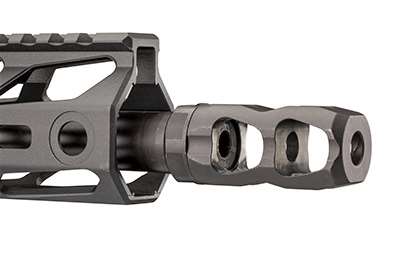
At the muzzle end of the barrel is a welcome feature on a lightweight .308 rifle: Ruger’s two-port Boomer muzzle brake. Surrounding the barrel and gas system is a 15" free-float aluminum handguard, featuring M-Lok accessory slots at the 3-, 6- and 9-o’clock positions. At the top, instead of a continuous Picatinny optics rail, a large portion of the material has been eliminated, leaving just a short, four-slot section near the muzzle for a front sight, as well as a seven-slot section at the rear of the handguard where it meets the receiver. Quick-detach sling swivel sockets are located at the 3- and 9-o’clock positions at the front of the handguard.
Some common features shared between SFAR and AR uppers include the same charging handle (meaning the SFAR can accept all mil-spec charging handles), dustcover and forward assist. The similarities between both platforms don’t end there, though. On the lower receiver, all AR-15 buttstocks and pistol grips will work on the SFAR, as well as drop-in triggers and receiver endplates. Worth noting, though, is that the endplate Ruger includes on the SFAR not only provides a QD sling swivel pocket, it also fills the missing space at the rear of the receiver usually covered up by the extended beavertail of AR grips like the included Magpul MOE grip. Replacing the OEM endplate will require the selection of an additional grip without the hand-filling beavertail. The Magpul MOE SL stock fits snugly onto the carbine receiver extension and provides five adjustment positions, as well as sling-loop points and a single QD sling swivel socket.
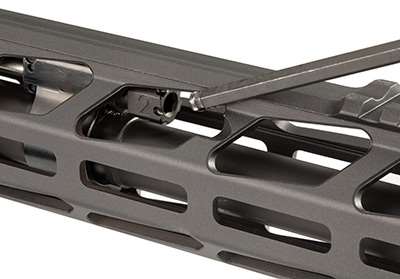
Control-wise, layout on the SFAR is utterly conventional. You’ll find the bolt-release lever on the left side of the receiver, and there’s a magazine-release button in its traditional, fenced-in spot on the right side of the receiver. The bolt catch is unique to the SFAR, with the actual catch being significantly larger than that found on the AR-15. However, despite the differences in magazines, the magazine catch on the SFAR is, dimensionally, the same as that on the AR-15.
Also similar between the two platforms is the safety selector, which, on the SFAR, is a standard, single-sided selector on the gun’s left side that rotates 90 degrees from Safe to Fire. The trigger itself, Ruger’s Elite 452 design found on the company’s other ARs, is a significant upgrade from what was found in its earlier SR-762 design. In our 2014 review, we noted that trigger pull was an issue, the single-stage design measuring in at a hair under 9 lbs., and remarked that the pull likely contributed to the rifle’s less-than-stellar accuracy. Ruger appears to have taken this critique to heart, because the SFAR trigger is a pleasant two-stage design with what the company describes as a “smooth, crisp” pull that, on our test sample, measured 4 lbs., 5 ozs.
Frankly, there aren’t many guns out there that fit the description of a “lightweight, semi-automatic .308 rifle,” but one thing is clear: despite being similarly sized to an AR-15, this isn’t one. AR-15s are lauded for their easy shootability, a feature that explains, in part, the rifle’s popularity. Stepping up to .308 Win. means stepping up felt recoil and muzzle rise, which is why the two-port muzzle brake on the SFAR is so welcome, though it is concussive.
I fired nearly 200 rounds through the Ruger, shooting everything from heavier, match-grade rounds to lighter practice fodder. Running the gamut from 150-grain loads up to 178-grain projectiles, the SFAR ran reliably, but I did have one incident on the range that pertains to the gun’s adjustable gas block. The gun shipped with its gas port adjusted to Setting 3, all the way open, and my mistake in this particular test was not double-checking the port setting before firing the first few shots. Fewer than 10 rounds in, extraction was so violent that a small shaving from the head of a fired case worked its way into the lower receiver and prevented the trigger from releasing the sear, ending my range day.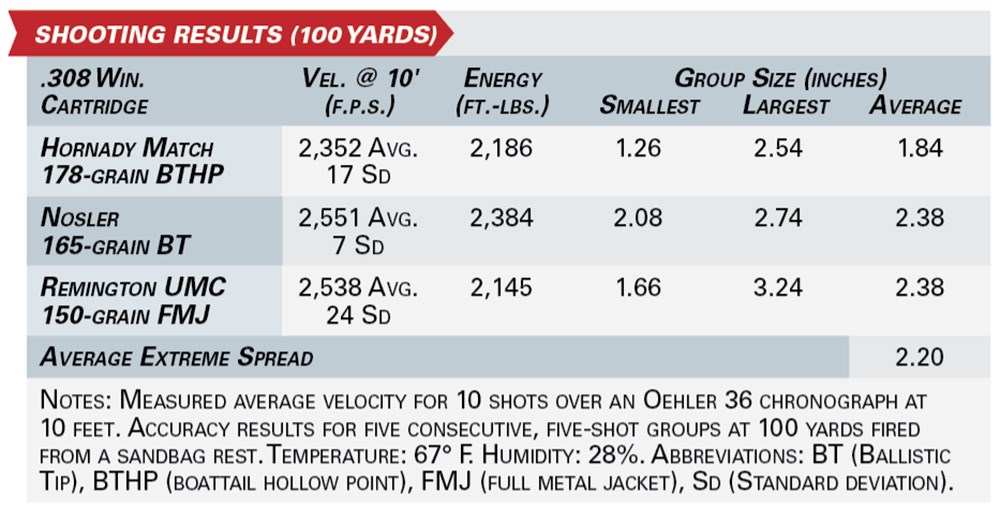
Cleaning out the receiver and re-adjusting the gas block to the mid-range setting, which Ruger recommends for most commercial ammunition, solved all issues, though there’s still a healthy amount of propellant gas cycling through the action even at Setting 2. Setting 1 is designed for use with suppressors, and Setting 0 shuts off gas flow entirely. Despite the hiccups at the beginning, though, the SFAR proved to be a reliable, accurate platform that handles and carries well.
Ruger’s SFAR means redemption for a design that’s largely been overlooked by most firearm enthusiasts. The AR-10 emerged at a time when wood-stocked battle rifles like the FAL and M14 were the norm. Today, most shooters don’t want big, heavy and unwieldy rifles like those of yesteryear for hunting, competition or home defense, and until now, most short-action ARs were exactly that. Price-wise and capability-wise, Ruger’s SFAR blends today’s most desirable firearm features with a heavy-hitting cartridge that, despite decades of ostensible development pointing away from .30-cal. cartridges, just keeps hanging on.
Love or hate the .308 Win., there’s no denying that it has staying power, particularly in the commercial market. Not only that, it has pure power, too, and the SFAR packages that in a platform that can be carried comfortably, shot well and used in a general-purpose role that the AR-15 just can’t approach. With the Ruger SFAR, we’re not just seeing a new take on the .308 AR—we’re seeing the next generation of short-action semi-automatics.
